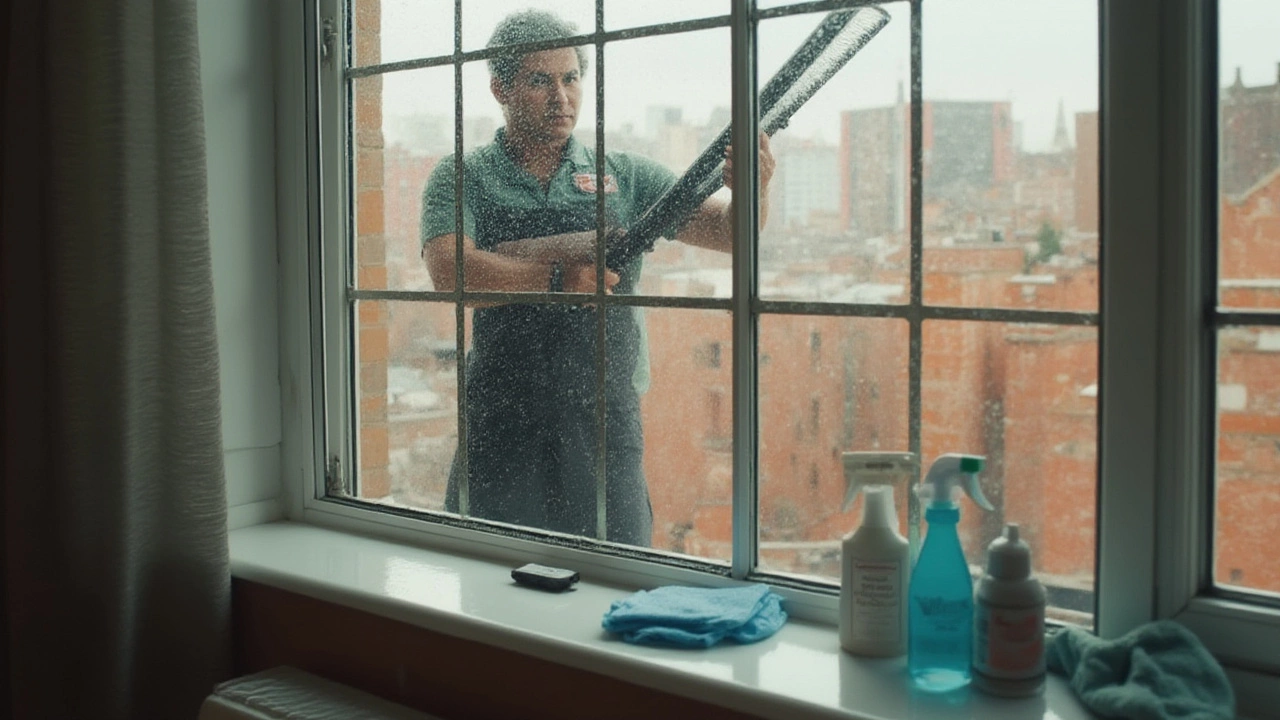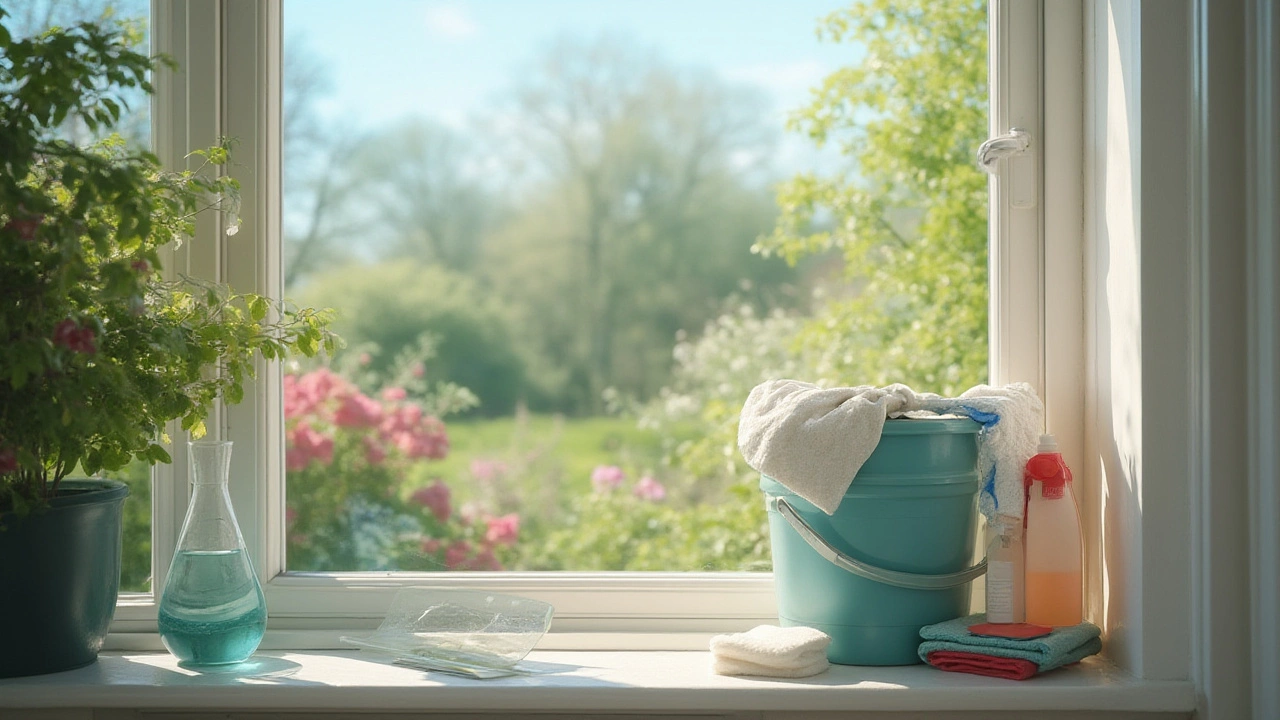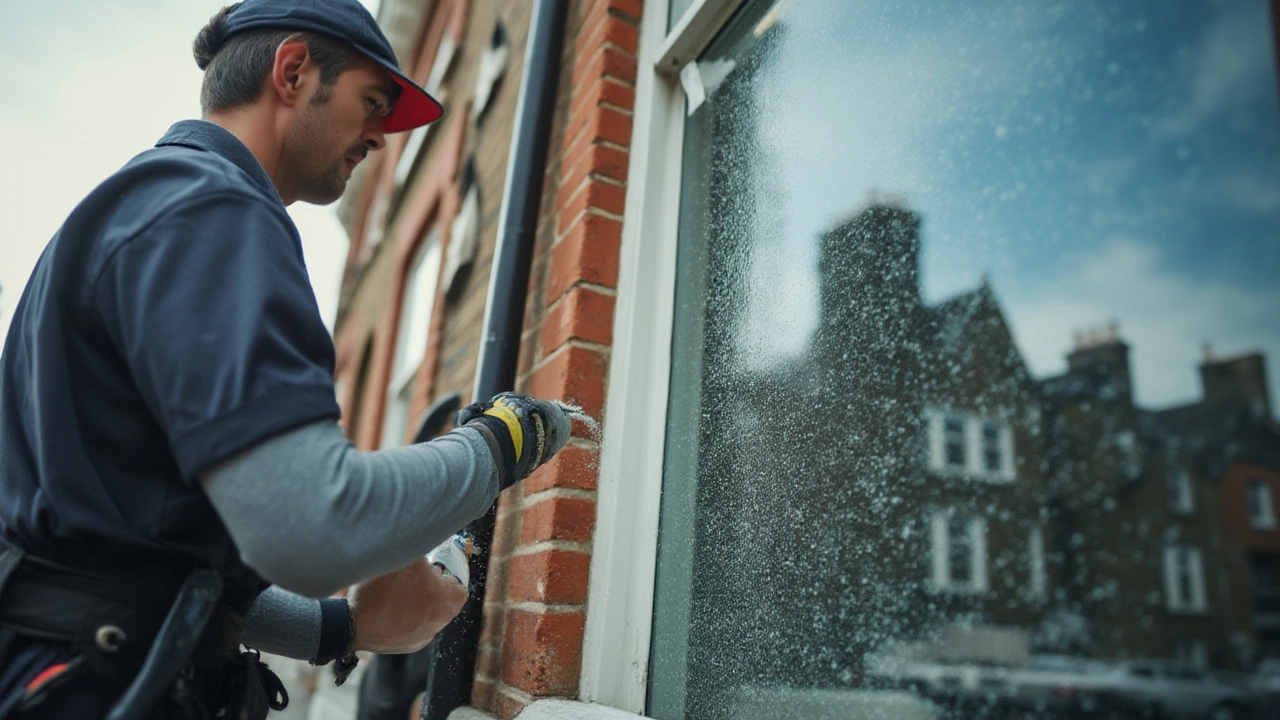Ever spotted a professional window cleaner at work and wondered how their glass ends up so spotless, almost invisible? There’s a bit of chemistry, a dose of savvy, and a mix of age-old tricks and next-gen tech behind that crystal-clear finish. If you’re tired of streaks, fingerprints, or mysterious marks that just won’t budge, the secret ingredient might not be sitting in your cleaning cupboard—unless you know what to look for. Let's go deep into the world of professional window cleaning and reveal what really goes in that bucket, van tank, or sprayer.
The Core Tools: What Do Pros Actually Put in Their Water?
Let’s cut to the chase. In 2025, the vast majority of pro window cleaners across the UK (and honestly, all over Europe now) swear by one main thing: ultra-pure water. That’s not a marketing term—it’s literally water that’s been stripped down to nothing but H2O. Every trace of minerals, metals, and impurities is filtered out, usually by reverse osmosis and a deionising process. Why go through all that effort? Because those minerals, especially calcium and magnesium, are the main reason you get annoying white streaks or spots when the water dries.
A look at a window cleaner’s van will usually reveal a hefty tank and a set of intricate filters. Here’s a basic breakdown of how it works:
- Water flows in from a regular tap.
- It goes through a series of filters: carbon, sediment, then a reverse osmosis membrane, and finally a deionising resin bed.
- What comes out the other end is pure water, usually tested with a TDS (Total Dissolved Solids) meter—it should read zero or very close to it.
If you’re picturing pros lugging round buckets of soapy suds, you’re picturing the 1990s. Yes, traditionalists still like a squirt of detergent—think Fairy Liquid or specialist window soap—but it’s the pure water systems, or “reach and wash” poles, that have revolutionised the trade. For windows above ground level or in hard-to-reach places, this system is a no-brainer. There’s no soap residue, so no rinsing is needed. And since the water is so pure, it just evaporates, leaving no marks. If windows are especially grubby (think post-pollen, coastal muck, or city grime), some still add a smidge of detergent. But for most jobs, pure water is king.
Some facts straight from the British Window Cleaning Academy: pure water can break down and lift dirt through a process called ionic attraction. In short, the ultra-clean water tries to bond with whatever’s on the glass, grabs onto dirt, and pulls it away. That sounds more like a science experiment than a cleaning job—yet that’s pretty much how it works. The trick only works because all impurities have been removed, so the water is ‘hungry’ for anything to dissolve.
Here’s a quick table of what you’ll find in a pro’s water—plus what you won’t:
| Ingredient | Purpose | Common? |
|---|---|---|
| Pure Water (0 TDS) | Main solvent for dirt removal | Yes – modern standard |
| Mild Detergent (e.g., specialist window liquid) | Removes greasy marks/organic residues | Occasionally, esp. indoors or on tough stains |
| Vinegar | Traditionally used for shine, but rare professionally | Rare; mainly in DIY |
| Rubbing Alcohol | Evaporates fast, used for spot cleaning | Rarely, on tough jobs |
| Ammonia | Breaks down tough grime | Less common due to smell/toxicity |
One thing you won’t see: supermarket glass spray. Those are fine for a quick wipe, but pro cleaners need consistent, spot-free results across dozens (sometimes hundreds) of panes a day. For that, household stuff just isn’t reliable enough.
The only exception? In major city centres or ancient buildings where water spots would be a disaster (think historic listed properties), cleaners might use specialist additives that prevent static build-up or rapid re-soiling. Some even have anti-fungal or anti-algae drops if the building is prone to these issues. But those are rare.

Why Ultra-Pure Water Is the Golden Standard
I know it sounds like a fad—ultra-pure water this, pure water that. But honestly, there’s a reason it’s taken off everywhere from Bristol to Berlin. First off, no matter how good your technique, if your water leaves mineral deposits, you’re going to have steak marks. That’s where pure water systems blow away the old mop-and-bucket approach.
Window cleaners who use these systems talk about how the water almost seems "magnetic" to dirt—an idea backed up by how pure H2O seeks to absorb minerals and grime by bonding at the ionic level. You run a brush attached to the carbon or glass fibre pole, rinse the window with that ultra-pure water, and let it dry. No need for squeegees or cloths, which can leave fibres or push muck around.
The British Window Cleaning Academy explains, "Windows cleaned with pure water dry spotless because the water contains no dissolved salts or impurities to leave behind. This is why pure water cleaning has become industry standard."
But here’s a wild stat: according to the Federation of Window Cleaners, use of pure water systems has grown by over 70% in the UK since 2010. That’s a massive shift in technique for what is, arguably, a very traditional trade.
So, what about indoors? Most pros switch back to traditional methods for interior glass. Why? You don’t want to saturate window sills, flooring, or electronics. Here’s where you might still see:
- Water and a dash of mild window cleaning soap (those specialist blue/green liquids you might have seen on cleaning supply sites—formulated to not streak).
- Top-quality, lint-free microfibre cloths—professionals invest in microfibre for quick absorption and no fibres left behind.
- Occasionally, a few drops of isopropyl alcohol for rapid evaporation on mirror-gloss glass or decorative panels.
Eco-conscious customers sometimes ask for vinegar or lemon juice. While those break down grease, they don’t cut it when it comes to professional-level, all-day, spot-free miles. Most pros politely sidestep household hacks in favour of science-backed options—either full-on pure water, or the mildest, most residue-free detergents available.
Want a tip for home? If you live in a hard water area, even using distilled water from the supermarket for that final rinse on the most visible panels (say, a big street-facing bay window) can get you close to pro results. It won’t break the bank and works way better than elbow grease alone.

Tricks of the Trade: Getting the Best Windows Possible
You ever notice how some window cleaners whiz through a block in half the time of others, but every single panel shines? Part of that’s practice, but part is about using the right method for the right glass. Here’s how they do it:
- Preparation is everything: The pros always brush off loose cobwebs, dirt, or sills before bringing water near the glass. Otherwise, mud just gets smeared around.
- Check the weather: Cleaning in direct sunlight is a rookie mistake—it dries the water too quickly, leaving streaks. Cloudy days or early mornings are prime time. Some seasoned locals keep a running list of which customers get which side of the house done first, just to chase the shade.
- Microfibre beats paper towels every single time: Normal cloths can create static, dragging dirt back onto the glass. High-quality microfibre, washed regularly, pulls away muck with zero residue.
- Know your glass: Some windows have coatings—UV, anti-glare, or self-cleaning—that react badly to heavy chemicals. Pure water or a mild soap is safest.
- Two-bucket method: Indoors, a pro never rinses a dirty squeegee or cloth in their clean water. They’ll have one bucket for soapy solution and another for rinse water. It keeps things way cleaner, way longer.
- Check the TDS: Even the best pure water system needs calibration. Water should test at or near 0ppm TDS (parts per million Total Dissolved Solids). Any higher, and spots are almost guaranteed.
If you’re going DIY, want a quick cheat sheet for streak-free glass?
- Start with a dry brush to dust frames and sills.
- Wash with a very mild solution—just a drop or two of window soap in a whole bucket (or use distilled water alone).
- Use a squeegee with a sharp, clean blade. Wipe the blade after every pass.
- Buff around the edges with a dry microfibre cloth. No cotton or kitchen roll!
- If you’re in a rush, old pantyhose (nylons) are amazing for last-minute shine—no fibres, no streaks.
Here’s a fun fact: the world record for the fastest window cleaning (set by Englishman Terry Burrows) is just under 10 seconds for three large windows. But the tools used? A regular squeegee, a traditional bucket, but—of course—ultra-pure water and top-notch detergent for maximum glide.
I once asked a local veteran cleaner here in Bristol what his number one tip was—he just grinned and held up a TDS meter. “Zero,” he said. That’s the secret. Not elbow grease, not a magic potion—just the right kind of water, and knowing when to use it.
